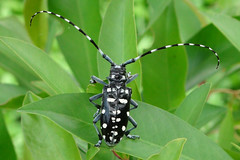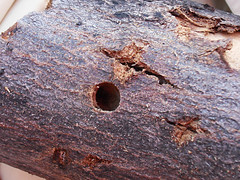 Asian long-horned beetle (Anoplophora malasiaca).
Asian long-horned beetle (Anoplophora malasiaca).
Photographer: Changhua Coast Conservation ActionThe Asian long-horned beetle (Anoplophora glabripennis) is a large and extremely destructive beetle that was probably imported from East Asia in wooden packing material in the 1990s.
Live adults have been destroyed in warehouses around North America. By 2017, tree infestations had been discovered in New York, Massachusetts, Ohio, Illinois (since eradicated), New Jersey (since eradicated), and Ontario, Canada.1 2 You can keep track of the insect’s spread on this USDA web page.
 Exit hole of the Asian long-horned beetle (Anoplophora glabripennis).
Exit hole of the Asian long-horned beetle (Anoplophora glabripennis).
Photographer: Flickr user sallahaHost trees include maples, box-elder, elms, birches, sycamores, and willows. The Asian long-horned beetle’s larvae tunnel through the tree’s vascular system and heartwood, eventually killing it. Tree infestations are recognized by the large round exit holes (at least the diameter of a ball-point pen, and sometimes dime-sized) that the beetle creates in the bark of large upper branches.3
The white-spotted, glossy black bodies of these winged adult beetles are ¾–1 ½ inches long. Their black-and-white banded antennae are up to 4 inches long! They should not be confused with the duller whitespotted sawyer which attacks conifers.
Infested trees must be cut down (after the first frost kills adult beetles) and chipped or burned to prevent spread. Early detection is crucial for beating the Asian long-horned beetle. You can help; visit this website to get started.
- 1. . 2017. Asian longhorned beetle.
- 2. . 2008. Asian longhorned beetle - Anoplophora glabripennis.
- 3. . 2017. Asian longhorned beetle.


